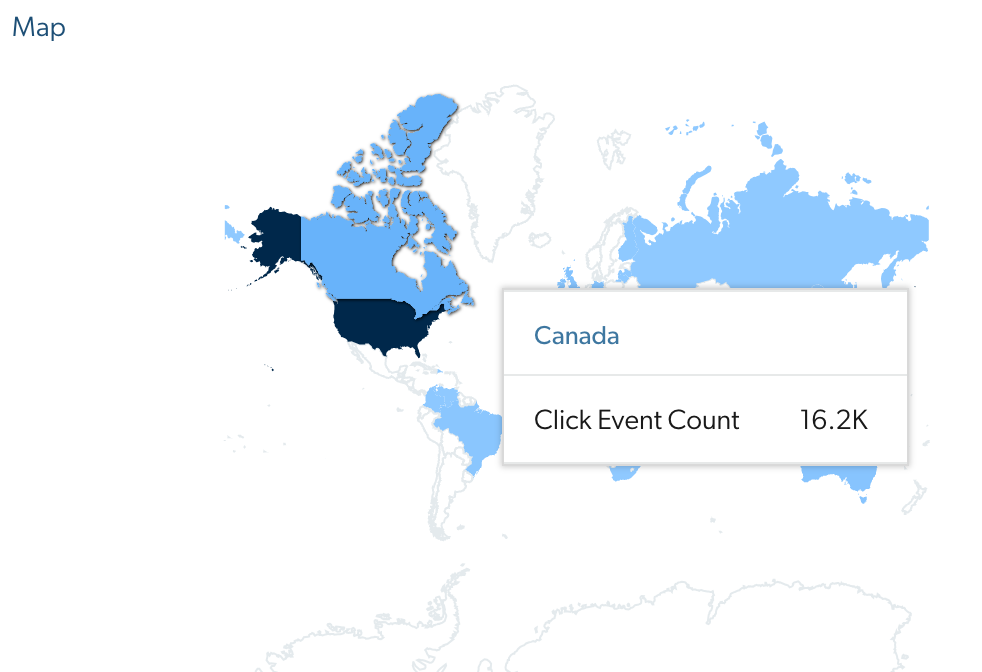Add map cards
Add map cards
Coveo Analytics dashboards offer many ways to review the data collected by Coveo Analytics. You can add map cards to dashboards to know the portrait of your users, such as user distribution world-wide, and review which countries have issues with adoption (for example, low search event count) or search relevance (for example, low clickthrough).

|
|
Note
The geo-mapping is done using the source IP address of the event performed by the users. |
Add a map card to a dashboard
-
In an existing dashboard, access Edit mode by clicking Edit in the upper-right corner.
NoteIn a new dashboard, the report is in Edit mode by default.
-
In a section, click Add card to section to access the Add a Card dialog.
You can also duplicate an existing card with
, and then only modify what needs to be different.
-
In the Add a Card dialog, under Graphs:
-
Select Map.
-
In the first input, enter a meaningful Card title, for example,
Visits With Clickthrough Lower Than 25%.NoteWhen you leave the box empty and save the dashboard, the card title will be [Selected Metric] per Country (for example,
Device Category per Country). -
Under Metric, click the dropdown menu, and then select one metric to show its values on a world map (for example, Visit Count).
-
(Optional) In the Advanced Settings section:
-
Click
, and then create one or more dimension filters (for example,
Search Event Clickthrough (%) < 25). -
When you report on a custom event and on a search or click event (you added a filter or selected a related metric) at the same time, or on an all event category metric or dimension (for example, Unique User IP and Browser), choose to Create a relation using the Last search or the Visit between the event categories.
Select Last search in situations where the last query performed by the user is the reason for the custom event.
For example, in Salesforce, when agents attached a result to a case (
caseAttach), the last query they made gave them the results they used to do the custom event.On the other hand, select Visit in situations where none of the queries performed by the user during the visit resolved their matter.
For example, when one of your clients creates a case (
caseCreate), they may have tried to get the information they needed by querying on the subject of their matter before doing the custom event. You can then use these queries to create knowledge base articles and therefore fill the content gap.Notes-
Custom data can only be leveraged when using the Coveo UA Protocol. If your Coveo implementation uses the Event Protocol, custom event types shouldn’t be added to a report since they won’t function as expected.
-
The Create a relation using parameter has no effect when you report only on search and click events.
-
Last search links each custom event to the query immediately preceding (if any) and Visit links each custom event to all queries performed during the user visit in which the custom event happened.
-
-
-
Click Add Card.
-
-
Back on the dashboard, click Save in the upper-right corner.
Review map card content
-
On the Reports (platform-ca | platform-eu | platform-au) page, click the report containing the map cards you want to review, and then click Open in the Action bar.
-
For every map cards, you can:
-
Hover over the card, and then click
or
to zoom in or zoom out.
-
See the metric count for each country and the percentage that this count represents on the metric total count by hovering over a country of the map card.
-
Filter the report by only keeping the data of a country by clicking a country in the map card.
-
Add or remove a dimension value from the map by hovering over a value in the chart legend and then clicking Hide/Show.
-
Required privileges
The following table indicates the required privileges to view and edit dashboards from the Reports (platform-ca | platform-eu | platform-au) page and associated panels (see Manage privileges and Privilege reference).
Access to dashboards or part of their content may be further restricted as a function of the member (see Manage access to reports and Manage permission filters).
| Action | Service - Domain | Required access level |
|---|---|---|
View dashboards |
Analytics - Analytics data |
View |
Edit dashboards |
Analytics - Analytics data |
View |
Analytics - Reports |
Edit |
|
Analytics - Administrate |
Allowed |